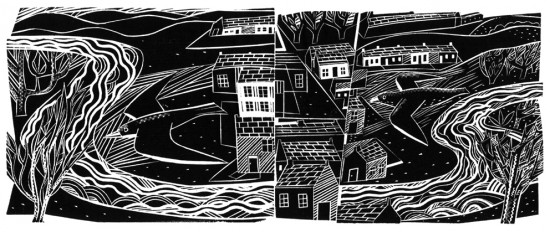 illustration by Jonathan Gibbs
illustration by Jonathan Gibbs
By Neil Sentance.
1980: Abandoning the Shade: The River, the Hills and the Hollows.
I grew up a few streets away from the River Witham, and though I haven’t lived there for many years, belonging has a steadfast grip. It was a place of mossy banks and murky water, where sunburnt summer kids played among the shoals and riffles, piratical with wooden swords, dangling from one bank to the other on tyre-and-rope swings – Dad even made me a buccaneer’s dagger, a snickersnee, from the clothes prop, much to my mother’s annoyance. We’d go fishing in Wyndham Park, where we’d spot rare native white-clawed crayfish in the pools near the inflow of the culverted Mowbrook, and watch the swales of martins the colour of sump oil skimming over the water. House sparrows teemed in the hawthorn, so common as to almost go unnoticed. Sometimes I’d take my 1960s copy of The Observer’s Book of Birds, re-covered in brown paper and re-bound with electrical tape, but mostly I’d be deep into the day-long games of cricket in the bankside pasture, where the fielders bound into the river like eager dogs and countless tennis balls were lost in the reeds.
In winter, taking the riverside walk edged by wind-rattled trees, we would make our way past the telephone exchange to London Road football ground, now predictably the site of a supermarket. Then it was a three-sided near-derelict stadium built on the floodplain and open on the south side, where the cricket square was roped off. Every other weekend we would watch Town struggle in the mid-reaches of the Northern Premier or the Midland Leagues. We’d skitter over the dilapidated wooden stands in the glare of the looming new floodlights, until the old men who’d been sitting in the decaying seats every Saturday since before the war would bellow at us to pack it in. Adding our small straining voices to the roars of the crowd, a few hundred die-hards too stubborn or hard up to go to Forest or County, we’d shout for an hour and a half, till our throats were raw and rasping behind tight-wound scarves. The river received its share of footballs booted out of the ground by a lumbering centre-half – you’d see them there bobbing like buoys in the dusklight on the walk home.
Sometimes we would cross town to the Canal, sleeving its way to Nottingham, where Alan Sillitoe writes of undefeated Arthur Seaton fishing from the towpath at the end of Saturday Night and Sunday Morning: ‘whenever you caught a fish, the fish caught you’. More usually, we’d cross over the Bridge End Road, past the river mill, and into Dysart Park, and take a dip in the lido, where several generations of the family had learnt to swim. The water was as cold as a mountain rill and full of floating dead flies or exhausted beetles – we would mount rescue missions, mostly in an effort to stave off the chill. From there we would take the primrose path up Cold Harbour Lane to the Hills and Hollows, along stony tracks and through kissing gates, up to where hawks soared and newly-colonising collared doves called in the spinneys. From the high terrace paths we could see over to Beacon Hill, which had carried firelight messages in the pre-modern age, and Belton House, serene in its parkland, and through the Witham gap to the white cooling towers on the Trent. Up here, among the redbrick ruins of Walters’s farm, we once found a bird’s nest inside a rusted mangel-wurzel chopper. Old mobile chicken huts were left stranded under hedgerows, wormy sides collapsed in on themselves, corroded iron wheels now sank into the soil. Pungent tiers of wild garlic clouded the banks of thigh-high stinging nettles. We soon got to know where dock leaves were to be found.
Reaching back to childhood now, I look through a dust-covered window. As Laurie Lee says in his poem of childhood-memory, ‘The Abandoned Shade’, ‘the voice of the boy, the boy I seek, within my mouth is dumb’. But the writer Bruce Chatwin often recounted Proust’s notion that the walks of our childhood provide ‘the substance of our “mental soil” – to which for ever after we are bound’. For me, it’s a soil warmed by a quiet sun and cut through by the shining river.
Click here to read other Scenes from the Waterside
The author and the editors would like to thank Simon Lewin at St Judes gallery for his help in finding the correct artist to illustrate this column. Thank you Simon and thank you Jonathan for your fine work.